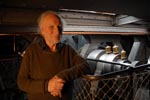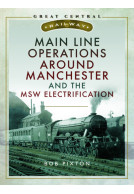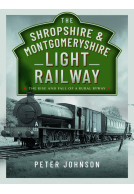George and Robert Stephenson (Hardback)
Pioneer Inventors and Engineers
Imprint: Pen & Sword Transport
Pages: 232
Illustrations: 50 black and white
ISBN: 9781526754981
Published: 14th September 2020
(click here for international delivery rates)
Order within the next 8 hours, 27 minutes to get your order processed the next working day!
Need a currency converter? Check XE.com for live rates
| Other formats available - Buy the Hardback and get the eBook for free! | Price |
|---|---|
| George and Robert Stephenson eBook (21.7 MB) Add to Basket | £9.98 |
This is a new biography of two great British engineering pioneers, who did much to develop the world we now live in.
George and Robert Stephenson were at the forefront of early railways and were at the cutting edge of modern engineering history.
Industrial historian Anthony Burton looks into these two giants of the late Georgian and early Victorian age, who were responsible for the development of much of the early railway map in both Britain and other parts of the world.
The work examines the lives of the two men and their ability to overcome some of the most pressing engineering problems of their time.
This is a new work, with newly researched material published here for the first time, which take a fresh look at both pioneering engineers and their achievements.
"For any reader coming to the Stephensons for the first time, this is an enjoyable read."
The Journal of The Stephenson Locomotive Society - No.933 Volume 98
It is some years since a book about both George and Robert Stephenson was published. It is good timing for a new one. A series of bicentenaries is imminent. Two hundred years ago George Stephenson was involved in the design and construction of a railway for the Hetton Coal Company in County Durham, which opened in 1822 with locomotives built by George at Killingworth colliery. In 1821 he had an historic meeting with Edward Pease at Darlington that resulted in him and his son Robert becoming involved in the creation in 1825 of the first public railway authorized to use locomotives, the Stockton and Darlington Railway (S&DR. This led to them being the most prominent pioneers of railways, not only designing and building railways but also developing and manufacturing the locomotives to operate them.
Hugh Fenwick, The Journal of the Friends of the National Railway Museum Spring 2021
This book takes the reader from George’s birth in a humble cottage near Wylam Colliery in 1781 to Robert being honoured with burial in Westminster Abbey in 1859, in recognition of his achievements and exceptional contribution to society. There are other books that focus separately on each of these two remarkable engineers and provide more detail about their lives and projects. This book looks at the two together; quite a task considering the vast number of projects they worked on during their relatively short lives. It is a compelling story, easy to read and providing a balanced summary of the men, their trials, tribulations and most significant projects.
The first chapter provides an account of the working conditions in the Tyneside collieries in the lates 1700s when George was a boy, the state of the development of the steam pumps for extracting water from the pits, and the tramways for transporting coal from the pit to the river. It sets the scene for the second chapter about George’s early working life, rising from assistant fireman for a pumping engine in his early teens to the skilled job of brakes-man for a Killingworth Colliery winding engine. From this experience he gained a thorough understanding of the workings of steam engines, which he applied to improve performance and output of the Killingworth colliery engines and won him promotion to engine-wright. Now he could provide his son Robert with the education he had wanted but could not afford.
George looked carefully at the various experiments being conducted at the time in the Newcastle area for using steam ‘travelling engines’ to replace horses to haul coal on the tramways. He gained the backing of his colliery owners and the Killingworth manager Nicholas Wood to build one and persuaded them to improve the track to support its heavy weight. The Killingworth railway demonstrated that using locomotives could be more profitable than horses. It was this that influenced the promoters of the S&DR to use locomotives for their railway. Young Robert left school in 1819 to be an apprentice to Nicholas Wood. He had grown up observing and learning his father’s work. In 1823 when his father, Edward Pease and others established the first locomotive manufacturing works at Newcastle, Robert at only twenty years old was made the managing partner. The first engines for the S&DR were built at the works.
The book goes on to relate the successful building of the S&DR, which earned George the reputation as the ‘must have’ engineer for building railways. This is followed by an account of the humiliation he suffered during the process of obtaining the Act of Parliament for the Liverpool & Manchester Railway (L&MR). The subsequent machinations in his being appointed engineer to build the line are also described. At this difficult time Robert was away in Columbia, South America setting up silver mines. His assistance was missed very much by George. However, a positive of outcome was Robert meeting Richard Trevithick and sharing ideas about improving steam locomotives.
George’s challenges of building the L&MR, the first inter-city railway in the world, are outlined including the conflicting opinions about the use of stationary engines versus locomotives for operating the railway that concluded with the Rainhill Trials. The Trials, the Trial competitors and the evolution of Rocket are covered, as is the grand opening of the railway in 1830. The success of the L&MR was assured by the performance of Rocket at the Trials and the further improved locomotives provided by Robert.
Success breeds Success. Both George and Robert were appointed to engineer many new railway projects that sprang from the completion of the L&MR. A chapter is given over to Robert’s role in the design and construction of the largest project ever attempted in Britain up to that time, the London & Birmingham Railway. Attention is given also to the work of the Newcastle locomotive factory under his guidance. Through the book personalities and prejudices for and against the Stephensons are presented. Special consideration is given to relationships with George Hudson ‘The Railway King’, the promoter of many railways engineered by the Stephensons. The different ethical values of Robert and Hudson become apparent.
A chapter is allotted to George’s gradual move from railway construction to colliery ownership, semi-retirement and his eventual demise in 1848. This period was exceptionally demanding for Robert. He was engineer-in-chief for the Chester & Holyhead Railway and the York, Newcastle & Berwick, both of which included massive bridges. The Chester & Holyhead was particularly difficult for him. In May 1847 one of the iron spans of the bridge across the River Dee at Chester collapsed with loss of life while a train was crossing. As chief engineer Robert was the principal witness at the inquest and technical enquiry. At the same time, he was immersed in the design and intensive testing programme to validate his design of the massive wrought iron tubular spans for the Britannia Bridge across the Menai Strait and the River Conwy crossing, the likes of which had never been attempted before. Additionally, his impressive Newcastle High Level and Berwick Royal Border Bridges were under construction.
Near the end of the book there is an overview of Robert’s projects in Europe and abroad. His other activities towards the end of his career are presented. He continued to be consulted on all manner of civil engineering issues. He was MP for Whitby and became involved in the Parliamentary Commission established to organise the Great Exhibition of 1851. In this role he was an enthusiastic supporter of the revolutionary design of the huge building, consisting of glass panes in an elaborate wrought-iron frame, which became known as The Crystal Palace. Robert Stephenson was President of the Institution of Civil Engineers in 1856 and 1857. He died in October 1859 aged just 56.
The penultimate chapter of the book ends with the note that Robert Stephenson was revered at the time as the greatest engineer of the day and given the same honour as that for the great engineer Thomas Telford in 1834; burial in Westminster Abbey, a great occasion befitting a great man.
The final chapter provides an assessment of the characters of George and Robert Stephenson. The only disappointment with this book is the number of minor errors. However, these do not detract from its substance.
I have really enjoyed this book, it is very well written and written to a high standard, I would certainly recommend this book to others but especially those who are studying the industrial revolution or the advancement of the 19th century in Britain.
UK Historian
Read the full review here
This volume gives a comprehensive insight not only into the lives of two quite remarkable engineers, but also the whole revolution, engineering, political and social that the building and operation of railways brought. Beyond that is their influence around the world. The book is real education about Victorian entrepreneurship, and is thoroughly recommended.
Ffestiniog Railway Magazine
At times, all of these men shared engineering challenges with the Stephensons and vice versa. Their collective achievements were amazing, in the true sense of the word, and this book amply does them justice.
The Railway Correspondence and Travel Society
As featured by
Railway & Canal Historical Society Journal
I have read many books on the Stephensons but mostly as individual biographies. This is a good book as their careers are intertwined and in that respect highly recommended. It is a good book for those studying engineering in the 19th century as it pulls together content from other sources. My only minor criticism was that it felt to me slightly biased when discussing their involvement with other contemporary engineers but that may be a personal opinion and should no way detract from the book.
James Simmonds
Overall I would recommend
About Anthony Burton
Anthony Burton has been writing about the history of transport and technology for fifty years. His books include Remains of a Revolution, The Railway Builders, The Locomotive Pioneers and biographies of Thomas Telford, George and Robert Stephenson and a biography of Marc and Isambard Brunel (due to be published in 2022). He has worked extensively in TV and most recently as historical adviser to the Discovery Channel series Industrial Revelations, More Industrial Revelations and On the Rails.
English engineer George Stephenson introduces his first steam locomotive
25th July 1814
English engineer George Stephenson introduces his first steam locomotive, a travelling engine designed for hauling coal on the Killingworth wagonway named Blücher
George Stephenson's "Locomotion No. 1" becomes the 1st steam locomotive to carry passengers on a public rail line
27th September 1825
George Stephenson's "Locomotion No. 1" becomes the 1st steam locomotive to carry passengers on a public rail line, the Stockton and Darlington Railway in England.
Joseph Locke Civil Engineer and Railway Builder 1805 - 1860 (Hardback)
Most historians recognise the work of three engineers as being the men who developed the railways from slow, lumbering colliery lines into fast, inter-city routes. Two are very well known: Robert Stephenson and Isambard Kingdom Brunel. The third was Joseph Locke, who should be recognised for having made a contribution just as great as that of the other two. The Locke family had been colliery managers and overseers for many generations and Joseph, once he had completed his very rudimentary education at Barnsley Grammar School at the age of thirteen, seemed set to follow in their footsteps. However,…
By Anthony BurtonClick here to buy both titles for £50.00























